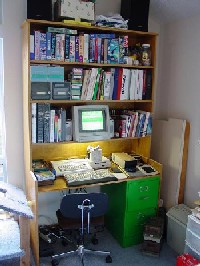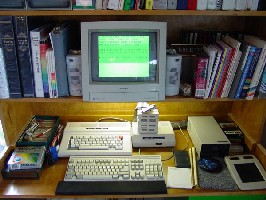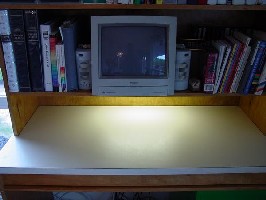Brendan's Classic Tandy Color Computer Series
Go back to Brendan's Classic Computers page.
Go to the Color Computer 3.
Browse offsite links to more about
Tandy/TRS-80 Color Computers.
Tandy Color Computer 2 (CoCo 2)
The Color Computer 2 was the first computer I had that was all mine to
do with as I pleased - it was our family's second "real"
(meaning not a video game console) computer. I used to drool over this little
machine in the old Radio Shack catalogs and show Dad how cool
they were! Little did I know just how cool they really were.
I remember getting this machine from one of the Radio Shack dealers in Las
Cruces, New Mexico. For those who have lived there for a long time (or long
ago), this was the one inside the Loretto Mall, which of course is long
gone. We wanted (or rather, Dad thought I should have) one with 64k RAM and
Extended Color Basic (ECB - more about that later). When we got home, we
discovered that it wasn't ECB, but only the standard Color Basic. After some
discussions and negotiations, Radio Shack replaced/upgraded it (I can't
remember which).
My early-model version had a keyboard that was a
little bit of a cross between the "chiclet-style" of the CoCo 1 (with its
somewhat short travel and rubbery feel) and the later CoCo 2 keys.
I really liked this keyboard, since the keys had little "wells" into which my
little fingers fit so nicely. It also had a cartridge slot on the right side
into which you could insert ROM-based "Program Paks" or other compatible
expansion hardware. Across the back were
a power button, a reset button, two analog joystick ports, a cassette drive
port, and a serial port.
This little machine had such an incredibly powerful basic interpreter that
I was completely absorbed by the included "Getting Started with Color
Basic" and "Going Ahead with Extended Color Basic" tutorial books.
They were very well written and clear enough, even, for a 4th grader to
understand (although I continued to read and refer to it through 8th grade).
Over time, I became incredibly glad that Dad had pushed for the ECB upgrade,
since I was able to utilize the high resolution graphics mode as well as the
additional single-voice sound capabilities in various and sundry games,
applications, and demos.
Later, this was also the machine with which I "cut my teeth" on assembly
language programming. (This was about the same time as I began using the
Microcomputer Trainer, too.) The beautifully
orthogonal instruction set of the little Motorola 6809 made it easy. I was
able to concentrate on various new concepts such as bases 2, 8, and 16,
registers, and addressing modes, and not concern myself with any architectural
oddities. I poured much time into my little book written by William Barden,
Jr., "Color Computer Assembly Language Programming", on road trips
in the camper from Washington through Idaho, Montana, Wyoming, the Dakotas,
Iowa, and Illinois.
It was in Washington state, in fact, where in 6th grade I made a good
friend, Steve, who happened to have a similarly equipped CoCo 1. He introduced
me to the CoCo-only Rainbow Magazine, which had tons of program listings, the
occasional easy hardware project, ads for peripherals, and more. He and I
spent many a day writing little programs utilizing all of the various
peripherals we had.
Peripherals that Dad (or later, myself) upgraded my little CoCo 2 with
included:
- A new Panasonic TV (10 or 11 inch diagonal viewable screen) with
a rotary "clicky" tuner, since, unlike the Apple II
series, the CoCo 1 and 2 only had modulated audio/video output on
channels 3 or 4. This little TV is still going strong and is now used in
the kitchen.
- A Tandy CGP-115 (Color Graphic Printer), which was actually a little
4-color plotter (black, red, green, and blue) with which Dad was able to
intrigue me demonstrating
Lissajous curves
(named for
Jules
Antoine Lissajous - you can experiment some more with them
here). Since
the plotter could be used in either a large 40-column or small 80-column text
mode or in an (x,y) graphics mode, it immediately became my hardcopying backup
and debug buddy for programs and made for some very cool plots. Later, I had a
few problems with it not knowing where its pens were (x-axis), and we had
to ship it back to Tandy for repairs. This plotter not only had the standard
serial port (for CoCo connectivity) but also had a parallel port so it saw a
little use with our first PC (a Tandy 1000TL).
- A high-quality Panasonic cassette tape drive from which I could load
games and other programs and to which I could store my own programs or data.
Sadly, even though the tape deck was quite good, I had trouble keeping the
volume settings at the same level (or had trouble in the mid-80s finding good
blank tapes) so I'd sometimes have problems reading my programs back from
tape. I experienced such dissatisfaction with these problems (I was so
spoiled having used the Apple II series 5-1/4 inch
floppy drives with all their relative speed and reliability) that I remember
telling Dad that without a floppy drive upgrade, that this machine was mostly
worthless...which of course, in time, lead to the following upgrade...
- A Tandy FD-501 5-1/4 inch floppy drive (this was a 1/2 height drive
in a full height case) with controller cartridge. This was the most important
upgrade for the Color Computer - it lead into so many other things, from a
basic understanding of random-access binary and ASCII file I/O to much of my
early knowledge of kernel-based operating systems. It also lead into several
other "necessary" peripherals (such as a second single-sided double-density
half-height 5-1/4 inch drive from IBM to fit into the same case).
- A custom made birch-veneered computer desk which had a removable
formica-covered writing surface/computer dust cover. Dad, Mom, and I built
this specifically for my CoCo 2 with lots of shelving (the lowest specifically
for the Panasonic TV) and a flourescent light under the lowest shelf for either
the writing surface or to light the computer work area. This desk is still in
use today with my CoCo 3.
 |

Now you see it... |

Now you don't... |
- A Multi-Pak Interface, expanding the single cartridge slot into four slots
that you could either select between or, as I usually did, simply leave the
disk controller plugged into slot 4 (as required) and set the Multi-Pak
selector switch to 4. Other cartridges, such as
the Speech/Sound Pak and the CoCo Max high resolution
joystick interface (more about these below) were addressable via software in
the other slots, so the selector switch didn't often have to be moved.
- A Speech/Sound Pak, allowing for speech and 3-voice sound, all through the
TV speaker. This could be accessed simultaneously with the disk drive via the
Multi-Pak Interface or a Y-cable, the latter of which I've never seen nor
tried.
- An Orchestra90-CC Pak allowing for 5 simultaneous voices in stereo via its
pair of low level RCA outputs (or monaural via the TV speaker). Steve and
I programmed tons of songs into this combination hardware interface,
"compiler", and built in editor. Of course, having this Pak mounted in the
Multi-Pak allowed us to save our Orchestra90-CC music files to disk.
- A Colorware CoCo Max Hi-Res Input Module high resolution joystick
port cartridge for use with the CoCo Max drawing program which would allow
higher precision than the 6-bit (0 to 63) analog to digital converters in
the CoCo itself.
- A Tandy DMP-130 dot matrix printer with both serial and parallel ports. I
printed numerous papers and listings on this printer along with CoCo Max
output, and Steve and I also did some manual raster programming of it to draw
specific graphics. Later, this printer did double duty on our Tandy 1000TL,
making use of its parallel port.
- A pair of Deluxe Joysticks. These joysticks had the ability to select
two different modes for each axis, a "spring back to center" mode and a mode
where the stick stayed where it was left and provided little resistance.
Because they had a "spring back" mode, they also had trim controls. The first
of these had only one button, but a later one had a pair of buttons, the
second of which was used only by the CoCo 3 if I remember correctly.
- A cool 3-ring binder that had 12 pressure sensitive switches in it, called
the "Electronic Book", into which you could place sheets providing a
picture-based user interface for a particular game program. The game programs,
of course, were pre-programmed to recognize the locations of the switches.
Various software that that Dad provided me with or I puchased later on came in
multiple different forms: Program Paks (ROM cartridges), cassette tapes, and
floppy disks. Here are my software-only Program Paks:
- Games
- Popcorn (26-3090 Copyright 1981)
The first Program Pak Dad
bought for me (along with the computer purchase). In this
game, you had to catch popcorn falling from the ceiling in
your frying pans.
- Gomoku/Renju (26-3089 Copyright 1983)
A game similar to Othello.
- Robot Battle (26-3070 Copyright 1981)
A really cool game in which you could
program your robot (using a built-in command language) to go
to battle against other robots.
- Downland (26-3046 Copyright 1983)
An arcade adventure game. (Acquired 2001.)
- Silpheed (26-3054 Copyright 1988)
An arcade space shoot-'em-up. (Acquired 2001.)
- Galactic Attack (26-3066 Copyright 1982)
Another arcade space shoot-'em-up. (Acquired 2001.)
- Androne (26-3096 Copyright 1983)
A old-style 3-D first person shooter type game. (Acquired
2001.)
- Chess (26-3050 Copyright 1980) - Acquired 2001.
- Castle Guard (26-3079 Copyright 1981) - Acquired 2001.
- Starblaze (26-3094 Copyright 1983) - Acquired 2001.
- Spidercide (26-3049 Copyright 1983)
From what I remember, this game was
reminiscent of the arcade game Qix. (Acquired 2001.)
- Dino Wars (26-3057 Copyright 1980)
Battle your dinosaur against another. (Acquired 2001.)
- Math Bingo (26-3150 Copyright 1980) - Acquired 2001.
- Productivity
- Typing Tutor (26-3152 Copyright 1980)
A recently acquired (2001) Program Pak
to teach basic typing skills.
- Personal Finance (26-3101 Copyright 1980)
Another recently acquired (2001)
Program Pak for handling finances/budgets.
- Programming
- EDTASM+ (26-3250 Copyright 1981)
This is the first editor/assembler I ever
used. It wasn't incredibly intuitive, but it was still very useful and
I used this in combination with my "Color Computer Assembly Language
Programming" book. It came with a reference which included all the
opcodes for the 6809E.
Various other software titles:
- Games on tape:
- Pyramid - The was the first tape-based game I ever played and
never got too far. It had a text-based interface similar to Infocom
adventure games.
- Grobot - In this Learning Company game, you act as a space
farmer and attempt to grow various crops based on forecasted climate
changes.
- Maze Master - This was an Electronic Book game.
- Number Factory - This was an Electronic Book game.
- Shape Maker - This was an Electronic Book game.
- Word Wizard - This was an Electronic Book game.
- On diskette:
- Games
- Robot Odyssey - This Learning Company game is probably the
coolest educational game I have ever played. In this game, your
task is to wire up the logic gates, sensors, grippers, thrusters,
and antennas of your 3 robots to allow them to autonomously navigate
various mazes and perform various tasks. I consider it to be the
big brother to Rocky's Boots, another Learning Company game that I
first played on the Apple ][+.
- Programming and Languages
- Color Disk EDTASM - With an interface and functionality very
similar to the EDTSAM+
ROM Pak, the important feature this provided was the ability to
save/load programs to/from floppy as well as providing routines
for use in your software.
- OS-9 Pascal
- D.L. Logo - So named because it was written by Dale Lear.
This was a really cool implementation of Logo that supported the
speech/sound pak and arbitrary-precision numbers. Excerpts
of the manual are scanned here.
Go to my home page.
Go to the polylith.com home page.
brendan@polylith.com